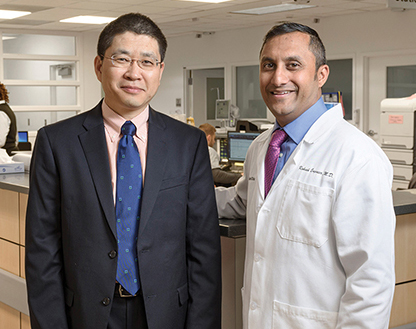Karen Titus
November 2017—The story of highly sensitive cardiac troponin, as written by Dr. Seuss, would provide a small twist. In this version, the Grinch doesn’t steal Christmas. Rather, he keeps delaying it, quarter after quarter, year after year.
“I remember maybe seven years ago, Roche told me their assay was coming. It’s coming, it’s coming, it’s coming,” laughs Sihe Wang, PhD, medical director and section head, clinical biochemistry, Cleveland Clinic, and clinical chemistry professor, Cleveland State University.

The Cleveland Clinic went live with Roche’s TnT Gen 5 Stat assay in June. “The only way to make a smooth transition is to have a team composed of all the stakeholders,” says Dr. Sihe Wang (left), here with emergency medicine physician Rakesh Engineer, MD.
“It was a long journey,” agrees Elsie Yu, PhD, system director of clinical chemistry, toxicology, and point-of-care testing, Geisinger Medical Laboratories, recalling the impatience with which she awaited FDA approval of a next-generation troponin assay. “And it wasn’t only me,” she says. “It was also cardiologists and the ED.”
At Brigham and Women’s Hospital, Boston, Petr Jarolim, MD, PhD, is familiar with the any-day-now chorus, having uttered it to his colleagues for eight long years. “I started making promises to my clinicians in 2009,” he says, laughing.
Finally, however, laboratories and their clinical colleagues can start unwrapping the package. The FDA cleared Roche’s TnT Gen 5 Stat assay earlier this year, and now physicians are implementing it, or at least considering whether to do so, as a way to more quickly manage patients presenting with chest pain.
Interestingly, for all the anticipation leading up to approval, the FDA asked the company to refer to its test as a “next-generation” assay, rather than a “high-sensitivity” assay.
That has made little difference to Dr. Yu. She had already assembled a team of physicians from cardiology and emergency medicine, as well as the laboratory, and was ready to act. (In hindsight, she says, her team should have included hospitalists as well.) “As soon as we heard the FDA approved it, we said, ‘OK, let’s see how we can implement this.’” Geisinger went live with the assay in September.
Her laboratory had two primary reasons for making the switch from the fourth-generation assay, says Dr. Yu. One was to shorten the rule-out algorithm for myocardial infarction. Using the previous assay meant taking measurements at zero and six hours, or using zero and serial measurements.
With a more sensitive test, the zero/three-hour algorithm “looks pretty solid,” she says, based on studies from Europe. (High-sensitivity cardiac troponin testing has been available outside the United States for about seven years.) Physicians are contemplating zero/two-hour or even zero/one-hour algorithms as well, she says. “Regardless, it’s a lot shorter algorithm for the ED to see if a patient has an MI.”
First of two parts
Next month: How emergency medicine physicians and cardiologists view next-generation troponin testing
The other attraction, Dr. Yu says, is that the newer assay will be more sensitive in detecting micro-MI. Aside from MI, she adds, the new troponin will have the advantage of detecting other types of myocardial injury. “It is a much better marker for cardiac function, so it gives more confidence in rule in/out. That’s something that excites our ED.”
Her cardiologist colleagues are excited as well. Even if the new assay translates into a heavier workload, in the form of more cardiology consults—a common fear with this test—she says they relish the thought of identifying patients in need of treatment sooner rather than later.
At Brigham and Women’s Hospital, Dr. Jarolim and colleagues were hoping to go live with the
Gen 5 in November. In his view, “It is clearly a better assay” compared with earlier generations of tests. “No question about it,” says Dr. Jarolim, director of clinical chemistry and the biomarker research and clinical trials laboratory, and professor of pathology, Harvard Medical School. “We will definitely shorten the [testing] intervals,” he says. “We are even considering moving to a one-hour rule out/rule in.”
The Cleveland Clinic Health System beat others to the punch, going live with the assay in June. Dr. Wang, too, worked with a team of providers, which in addition to the usual suspects—lab, cardiology, ED—included nursing and internal medicine. “The only way to make a smooth transition is to have a team composed of all the stakeholders. Making a change is not easy,” says Dr. Wang.
He also benefited from a C-suite team, he acknowledges. The Cleveland Clinic Health System’s executive team essentially ordered the switch from on high, convinced it would improve patient care and save money, as well as possibly enhance the institution’s reputation for providing high-quality cardiac care. “When your CEO tells you to do it, guess what?” Dr. Wang says with a laugh. It likely helped that the CCHS’ chief medical operations officer is the interim chair of pathology and laboratory medicine, he adds.
Dr. Wang recites the aforementioned reasons for the lab wanting to adopt the new assay, then adds an unexpected benefit. Laboratory medicine isn’t always the most visible specialty among clinicians, he says, but moving to the newer assay gave him and his colleagues a reason to team up with clinicians. Thanks to the ongoing collaboration and a smooth transition, he says, “We’ve gained a lot of respect. We already had a good relationship, but it’s gotten even better.” Indeed, he jokes, the laboratory has become sort of a rock star—no small thing in Cleveland, given its proximity to a certain Hall of Fame.
 CAP TODAY Pathology/Laboratory Medicine/Laboratory Management
CAP TODAY Pathology/Laboratory Medicine/Laboratory Management
